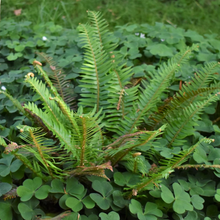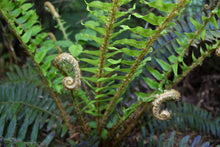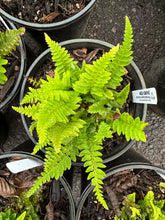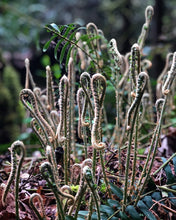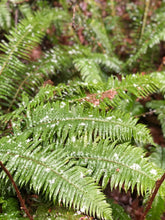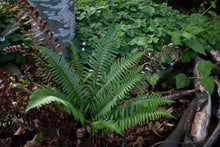
Polystichum munitum
Sword fern finds itself perfectly at home in shady woodland or rocky habitat gardens. This charming evergreen has tall arching fronds that appear prehistoric. Abundant new fiddleheads unfurl each spring into fronds that can reach up to six feet long, joining those from previous years, with a diagnostic small “thumb” at the bottom, making it resemble a sword. It is an exceptionally long-lived plant, with one mature plant boasting as many as 100 fronds, which adds visual interest and hardy structure to the garden all year.
- Plant type/canopy layer: evergreen, perennial, fern
- Size at maturity: 2-4' tall, 2-3' wide
- Light requirements: full shade, part sun/part shade
- Moisture requirements: moist to dry soil
- Bloom time: n/a, spores usually mature in July
- Growth rate/ease: medium growth rate, easy to grow
- Wildlife support: fronds provide cover and nesting sites for birds, small mammals and amphibians, and are browsed by deer, elk, black bear, and mountain beaver; overall plant is a caterpillar host plant and larval food source for native butterflies and moths
- Native habitat/range: found in the understory of moist coniferous forests and meadows, at low to mid elevations, from the Cascades to the coast throughout the Pacific Northwest from southeast Alaska to southern California. Portland Plant List - yes.
- Special features & uses: evergreen; deer resistant; fronds are harvested for use in floral arrangements and have been traditionally used by native peoples for lining baking pits and storage baskets, as placemats, floor coverings, and bedding, for games, skirts and other decorations; edible as a famine food - roots/rhizomes can be consumed in desperation and in small quantities due to possible presence of carcinogens or other toxins.
Gardening with Sword Fern: Sword fern will be happiest in your shady woodland garden, preferably in the understory of associate plants like conifers. Although many plant lists will tell you that sword fern survives the sun, it doesn't thrive there, particularly in the extreme summer heat that climate change has brought. Ideal soils for this species are well-drained, rich in humus (organic matter) and contain small stones. That said, it is highly tolerant of a wide range of soil conditions including those that are nutrient poor and not well-draining. Sword ferns are very tough, and can survive summer drought once established.
Photo Credits: 1-3 & 6: Nikkie West, Sparrowhawk Native Plants
Photo Credits 4 & 5: Tara Lemezis






